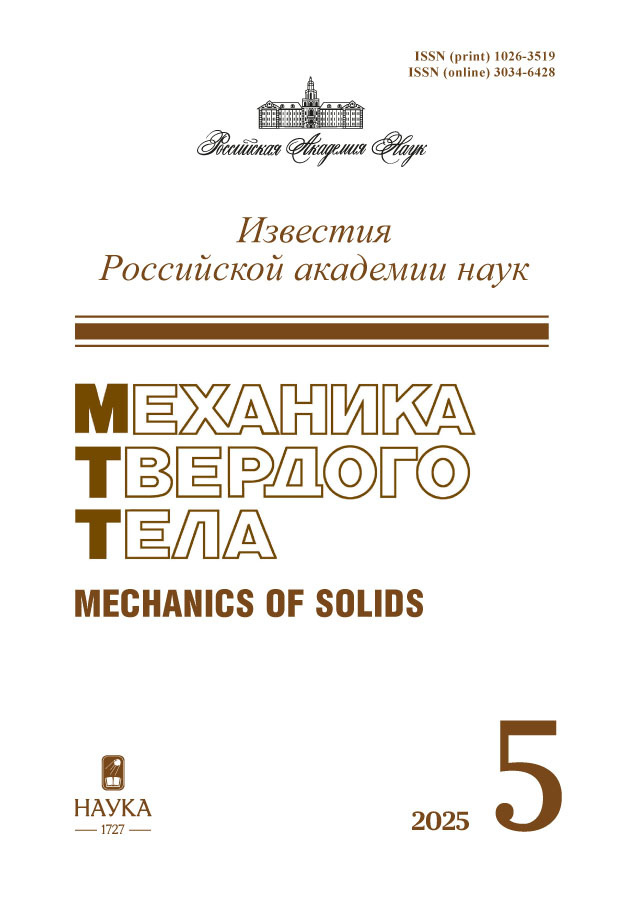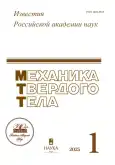A model of diffusion annihilation of gas-filled spherical pores during hot isostatic pressing
- Authors: Epishin A.I.1, Lisovenko D.S.2, Alymov M.I.1
-
Affiliations:
- Merzhanov Institute of Structural Macrokinetics and Materials Science of the RAS
- Ishlinsky Institute for Problems in Mechanics of the RAS
- Issue: No 1 (2025)
- Pages: 136-157
- Section: Articles
- URL: https://gynecology.orscience.ru/1026-3519/article/view/680991
- DOI: https://doi.org/10.31857/S1026351925010071
- EDN: https://elibrary.ru/tadoiq
- ID: 680991
Cite item
Abstract
A diffusion model of dissolution of gas-filled spherical pores in a solid during hot isostatic pressing (HIP) is proposed. It is assumed that the pore surface emits vacancies when a solid is loaded with external pressure, as a result of which the pores shrink in size. Two specific cases are considered: pores with a constant amount of insoluble gas and pores with a gas diffusively dissolving in the material surrounding the pore. In the first case, the increasing internal pressure of the gas in the pore first slows down the process of pore contraction and finally stops it completely when the internal pressure of the gas in the pore becomes equal to the sum of the externally applied HIP pressure and the Laplace pressure due to the pore surface tension. In the second case, the internal gas pressure in the pore decreases rapidly due to the dissolution of the gas in the material surrounding the pore and therefore pore contraction does not stop. When the pore reaches a sub-micron size, the pore contraction is quickly accelerated due to the increasing Laplace pressure and finally the pore annihilates.
Full Text
About the authors
A. I. Epishin
Merzhanov Institute of Structural Macrokinetics and Materials Science of the RAS
Author for correspondence.
Email: a.epishin2021@gmail.com
Russian Federation, Chernogolovka
D. S. Lisovenko
Ishlinsky Institute for Problems in Mechanics of the RAS
Email: lisovenk@ipmnet.ru
Russian Federation, Moscow
M. I. Alymov
Merzhanov Institute of Structural Macrokinetics and Materials Science of the RAS
Email: a.epishin2021@gmail.com
Russian Federation, Chernogolovka
References
- Alymov M.I., Shustov V.S., Kasimtsev A.V. et al. Synthesis of titanium carbide nanopowders and production of porous materials on their basis // Nanotechnol. Russia. 2011. V. 6. P. 130–136. https://doi.org/10.1134/S1995078011010022
- Gnedovets A.G., Zelenskii V.A., Ankudinov A.B. et al. Hierarchically structured, highly porous nickel synthesized in sintering–evaporation process from a metal nanopowder and a space holder // Dokl. Chem. 2019. V. 484. P. 64–67. https://doi.org/10.1134/S0012500819020022
- Jeon T.J., Hwang T.W., Yun, H.J. et. al. Control of porosity in parts produced by a direct laser melting process // Appl. Sci. 2018. V. 8. P. 2573. https://doi.org/10.3390/app8122573
- Galarraga H., Lados D.A., Dehoff R.R. et. al. Effects of the microstructure and porosity on properties of Ti-6Al-4V ELI alloy fabricated by electron beam melting (EBM) // Additive Manufacturing. 2016. V. 10. P. 47–57. https://doi.org/10.1016/j.addma.2016.02.003
- Epishin A.I., Alymov M.I. Determination of the volume fraction of microporosity in single crystals of nickel-based superalloys // Inorg. Mater. 2023. V. 59. P. 1496–1503. https://doi.org/10.1134/S0020168523150037
- Fullagar K.P.L., Broomfield R.W., Hulands M. et. al. Aero engine test experience with CMSX-4® alloy single-crystal turbine blades // J. Eng. Gas Turbines Power. 1996. V. 118. P. 380–388. https://doi.org/10.1115/1.2816600
- Epishin A., Fedelich B., Link T. et. al. Pore annihilation in a single-crystal nickel-base superalloy during hot isostatic pressing: Experiment and modelling // Mater. Sci. Eng. A. 2013. V. 586. P. 342–349. https://doi.org/10.1016/j.msea.2013.08.034
- Epishin A.I., Link T., Fedelich B. et. al. Hot isostatic pressing of single-crystal nickel-base superalloys: Mechanism of pore closure and effect on mechanical properties // MATEC Web of Conf. 2014. V. 14. P. 08003. https://doi.org/10.1051/matecconf/20141408003
- Kosonen T., Kakko K., Raitanen N. Evaluation of pore re-opening after HIP in LPBF Ti–6Al–4V // Powder Metallurgy. 2021. V. 64. № 5. P. 425–433. https://doi.org/10.1080/00325899.2021.1928997
- Reed R.C., Cox D.C., Rae C.M.F. Damage accumulation during creep deformation of a single crystal superalloy at 1150°C // Mater. Sci. Eng. A. 2007. V. 448. № 1–2. P. 88–96. https://doi.org/10.1016/j.msea.2006.11.101
- Morozov E.M., Alymov M.I. Fracture pressure in microdefects of consolidated materials // Dokl. Phys. Chem. 2021. V. 501. P. 111–113. https://doi.org/10.1134/S0012501621110026
- Sofronis P., McMeeking R.M. Creep of power-law material containing spherical voids // J. Appl. Mech. V. 59. № 2S. P. S88–S95. https://doi.org/10.1115/1.2899512
- Levinsky Yu.V. The behavior of closed pores at the final stage of sintering // Russ. J. Non-Ferrous Metals. 2009. V. 50. № 3. P. 298–316. https://doi.org/10.3103/S1067821209030225
- Prasad M.R.G., Gao S., Vajragupta N., Hartmaier A. Influence of trapped gas on pore healing under hot isostatic pressing in nickel-base superalloys // Crystals. 2020. V. 10. P. 1147. https://doi.org/10.3390/cryst10121147
- Ruffini A., Bouar Y. Le, Finel A., Epishin A.I. et.al. Dislocations interacting with a pore in an elastically anisotropic single crystal nickel-base superalloy during hot isostatic pressing // Comp. Mater.s Sci. 2022. V. 204. P. 111118. https://doi.org/10.1016/j.commatsci.2021.111118
- Feldmann T., Fedelich B., Epishin A. Simulation of hot isostatic pressing in a single‐crystal ni base superalloy with the theory of continuously distributed dislocations combined with vacancy diffusion // Adv. Eng. Mater. 2022. V. 24. № 6. P. 2101341. https://doi.org/10.1002/adem.202101341
- Sakai T., Iwata M. On the final stage in pressure sintering process // Jpn. J. Appl. Phys. 1976. V. 15. № 3. P. 537–542. https://doi.org/10.1143/JJAP.15.537
- Wang H., Li Z. Diffusive shrinkage of a void within a grian of a stressed polycrystal // J. Mech. Phys. Solids. 2003. V. 51. № 5. P. 961–976. https://doi.org/10.1016/S0022-5096(02)00039-X
- Epishin A.I., Bokstein B.S., Svetlov I.L. et. al. A vacancy model of pore annihilation during hot isostatic pressing of single crystals of nickel-base superalloys // Inorg. Mater. Appl. Res. 2018. V. 9. P. 57–65. https://doi.org/10.1134/S2075113318010100
- Epishin A., Camin B., Hansen L. et. al. Refinement and experimental validation of a vacancy model of pore annihilation in single-crystal nickel-base superalloys during hot isostatic pressing // Adv. Engineering Mater. 2020. V. 23. № 7. P. 2100211. https://dx.doi.org/10.2139/ssrn.3751560
- Compaan K., Haven Y. Correlation factors for diffusion in solids // Trans. Faraday Soc. 1956. V. 52. P. 786–801. http://dx.doi.org/10.1039/TF9565200786
- Brillo J., Egry I. Surface tension of nickel, copper, iron and their binary alloys // J. Mater. Sci. 2004. V. 40. P. 2213–2216. https://doi.org/10.1007/s10853-005-1935-6
- Saaremaa E. The surface tension of solid nickel. University of British Columbia, 1957. 72 p. https://doi.org/10.14288/1.0081208
- Dwight H.B. Tables of integrals and other mathematical data. 3rd ed., New York, The Macmillan Company, 1957. 288 p.
- Harris K., Erickson G.L., Sikkenga S.L. et.al. Development of two rhenium- containing superalloys for single- crystal blade and directionally solidified vane applications in advanced turbine engines // JMEP. 1993. V. 2. № 4. P. 481–487. https://doi.org/10.1007/BF02661730
- Epishin A.I., Nolze G., Alymov M.I. Pore morphology in single crystals of a nickel-based superalloy after hot isostatic pressing // Metall. Mater. Trans. A. 2023. V. 54. № 1. P. 371–379. https://doi.org/10.1007/s11661-022-06893-x
- Engström A., Ågren J. Assessment of diffusional mobilities in face-centered cubic Ni-Cr-Al alloys // Z. Metallkd. 1996. V. 87. № 2. P. 92–97. https://doi.org/10.1515/ijmr-1996-870205
- Epishin A.I., Lisovenko D.S. Comparison of isothermal and adiabatic elasticity characteristics of the single crystal nickel-based superalloy CMSX-4 in the temperature range between room temperature and 1300 °C // Mech. Solids. 2023. V. 58. № 5. P. 1587–1598. https://doi.org/10.3103/S0025654423601301
- Brückner U., Epishin A., Link T. Local X-ray diffraction analysis of the structure of dendrites in single-crystal nickel-base superalloys // Acta Mater. 1997. V. 45. № 12. P. 5223–5231. https://doi.org/10.1016/S1359-6454(97)00163-8
- Krupp U., Christ H.-J. Internal nitridation of nickel-base alloys. Part I. Behavior of binary and ternary alloys of the Ni-Cr-Al-Ti system // Oxidation of Metals. 1999. V. 52. P. 277–298. https://doi.org/10.1023/A:1018843612011
- Wriedt H.A., Gonzalez O.D. The solubility of nitrogen in solid iron-nickel alloys near 1000 °C // Trans. AIME. 1961. V. 221. № 3. P. 532–535.
- Fromm E., Gebhardt E. Gase und Kohlenstoff in Metallen. Berlin: Springer-Verlag, 1976. 748 p.
- Park, J-W., Altstetter, C.J. The diffusion and solubility of oxygen in solid nickel // Metall. Trans. A. 1987. V. 18. P. 43–50. https://doi.org/10.1007/BF02646220
- Alcock C.B., Brown P.B. Physicochemical factors in the dissolution of thoria in solid nickel // Metal Science Journal. 1969. V. 3. № 1. P. 116–120. https://doi.org/10.1179/msc.1969.3.1.116
- Seybolt A.U. Dissertation, Yale University, New Haven, CT, 1936.
- Hansen M., Anderko K. Constitution of binary alioys. New-York.: Mc Graw-Hill, 1958. 989 p.
- David M., Prillieux A., Monceau D., Connétable D. First-principles study of the insertion and diffusion of interstitial atoms (H, C, N and O) in nickel // J. Alloys Compd. 2020. 822. P. 153555. https://doi.org/10.1016/j.jallcom.2019.153555
- Krupp U., Christ H.-J. Internal nitridation of nickel-base alloys. Part II. Behavior of quaternary Ni-Cr-Al-Ti alloys and computer-based description // Oxidation of Metals. 1999. V. 52. P. 299–320. https://doi.org/10.1023/A:1018895628849
Supplementary files












